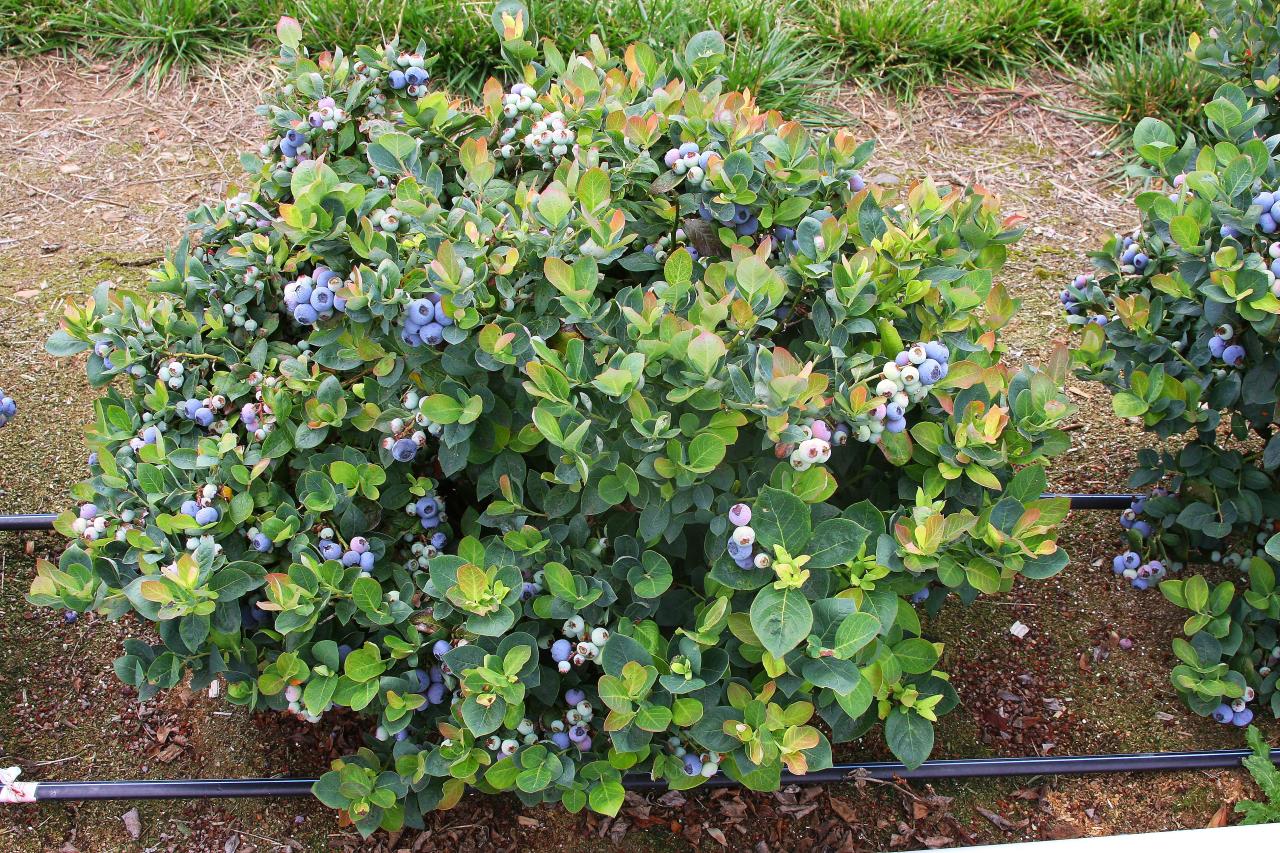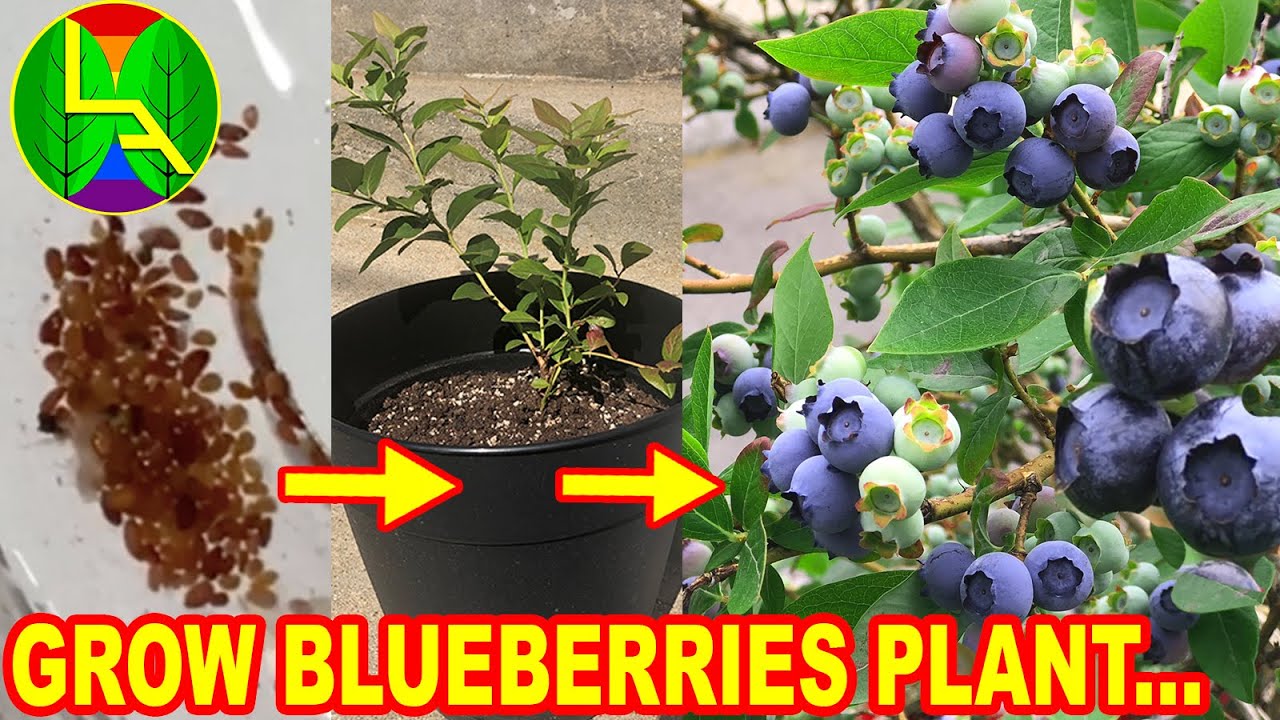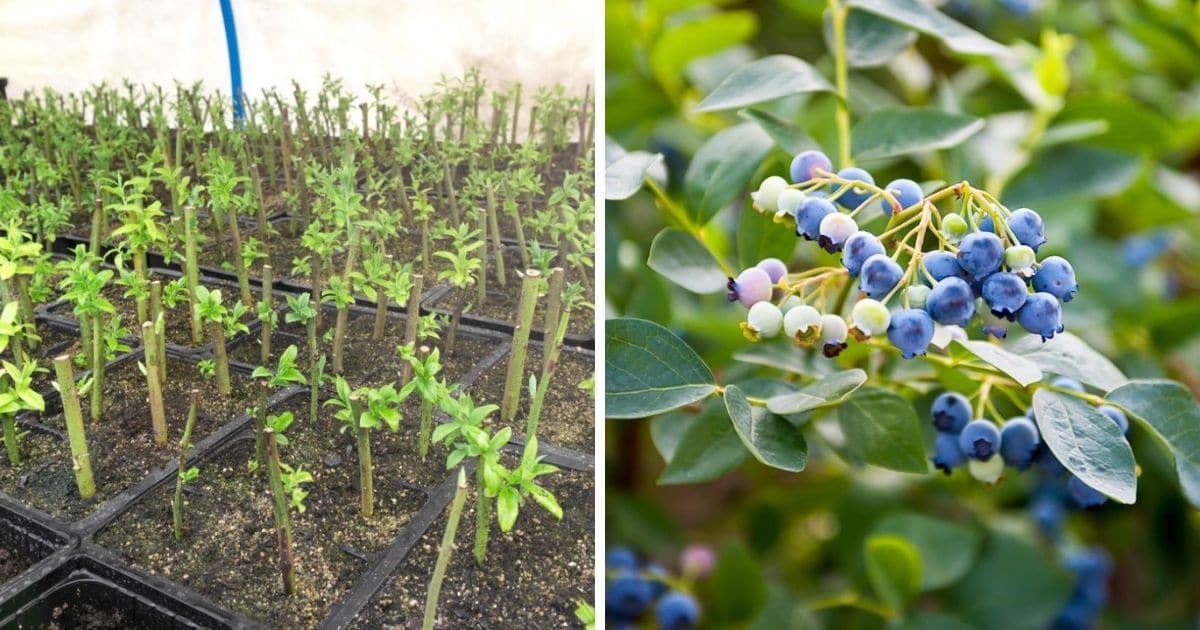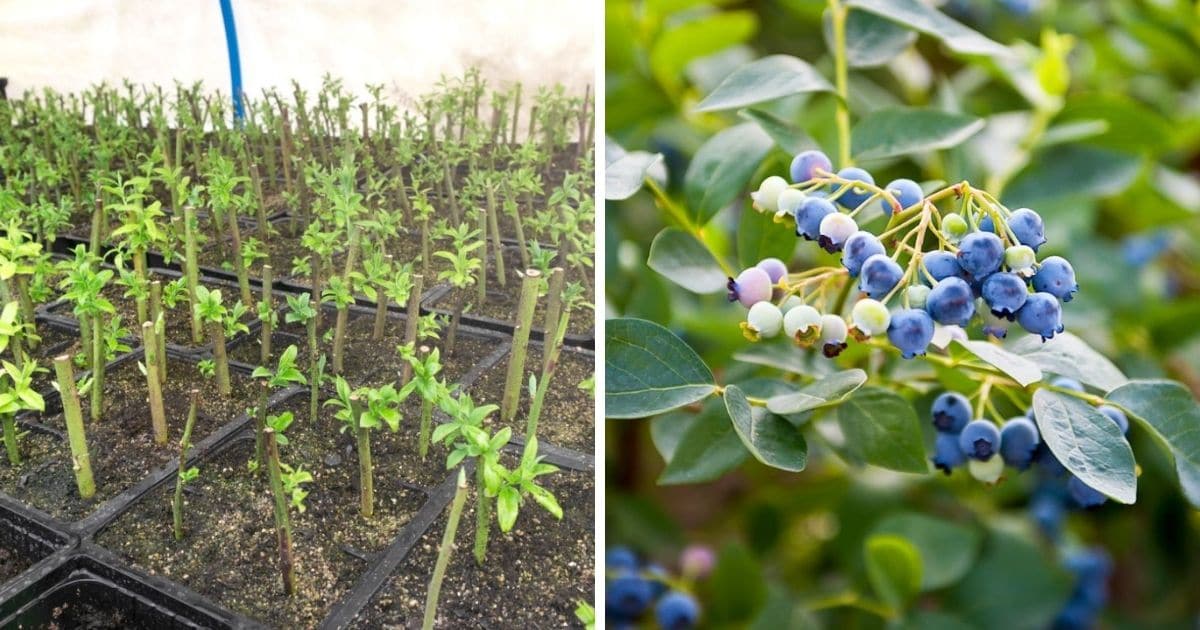How to Create a Thriving Blueberry Bush Garden with Proven Propagation Techniques: Imagine a bountiful harvest of sweet, juicy blueberries right in your backyard. Achieving this dream isn’t as complicated as you might think. By understanding the fundamentals of blueberry bush growth and mastering effective propagation methods, you can create a thriving blueberry garden that yields delicious fruit for years to come.
This comprehensive guide will take you through each step, from selecting the perfect location and soil to nurturing your bushes for optimal growth and bountiful harvests.
This guide will cover the essentials of cultivating a thriving blueberry garden, including soil preparation, sunlight requirements, watering techniques, and fertilization strategies. We’ll delve into proven propagation methods like cuttings, layering, and seed propagation, equipping you with the knowledge to expand your blueberry patch and share your passion with others.
From planting and establishing your garden to cultivating healthy bushes and maximizing your harvest, this guide provides all the information you need to enjoy the sweet rewards of a flourishing blueberry garden.
Understanding Blueberry Bush Growth: How To Create A Thriving Blueberry Bush Garden With Proven Propagation Techniques

Blueberry bushes are a popular choice for home gardeners due to their delicious fruit and attractive foliage. However, to ensure a thriving blueberry bush garden, it’s crucial to understand the specific requirements for their growth.
Ideal Soil Conditions for Blueberry Bushes
Blueberry bushes thrive in acidic soil with a pH range of 4.5 to 5.5. This acidic environment is essential for nutrient uptake, particularly for the absorption of essential nutrients like iron and manganese. The ideal soil should be well-drained, loose, and rich in organic matter.
- Adding organic matter:Incorporating organic matter like compost, peat moss, or pine needles into the soil helps improve drainage, aeration, and acidity. This amendment creates a favorable environment for root development.
- Testing soil pH:Regularly testing soil pH using a home pH kit is crucial to monitor acidity levels. If the pH is too high, you can lower it by adding sulfur, aluminum sulfate, or acidifying fertilizers.
Sunlight Requirements for Blueberry Bush Growth
Blueberry bushes require full sun to partial shade for optimal growth and fruit production. They need at least six hours of direct sunlight daily, but they can tolerate some shade, especially in hot climates.
- Full sun:In areas with cooler climates, full sun exposure is ideal, providing the maximum sunlight needed for photosynthesis and fruit development.
- Partial shade:In regions with hot summers, planting blueberry bushes in a location with partial shade during the hottest hours of the day can help prevent scorching and stress.
Proper Watering Techniques for Blueberry Bushes
Blueberry bushes need consistent moisture but are susceptible to root rot if the soil is constantly wet.
- Deep watering:Water deeply and infrequently, allowing the soil to dry slightly between waterings. Deep watering encourages root growth and minimizes the risk of shallow root systems.
- Mulch:Applying a layer of organic mulch around the base of the bushes helps retain moisture, suppress weeds, and regulate soil temperature.
Fertilizing Blueberry Bushes for Healthy Growth
Blueberry bushes benefit from regular fertilization, especially during the growing season.
Creating a thriving blueberry bush garden requires a combination of proper soil, sunlight, and, most importantly, successful propagation. While blueberry bushes can be grown from seed, the most efficient method is through cuttings, similar to the benefits outlined in Why African Violet Propagation is the Best Way to Grow Plants.
By using cuttings, you can ensure that your new blueberry bushes inherit the desirable traits of their parent plants, leading to a healthy and productive garden.
- Acidic fertilizer:Use a fertilizer specifically formulated for acid-loving plants, such as azaleas, rhododendrons, and blueberries. These fertilizers contain essential nutrients in an acidic form that blueberry bushes can easily absorb.
- Timing:Fertilize blueberry bushes in early spring before new growth emerges and again in mid-summer after the first harvest. Avoid fertilizing in late fall, as it can stimulate late growth that may be susceptible to winter damage.
- Organic options:Organic fertilizers, such as compost tea or fish emulsion, can provide essential nutrients and improve soil health.
Propagation Techniques
Propagating blueberry bushes is a rewarding way to expand your garden and share your love of these delicious berries. Several methods are available, each with its own advantages and considerations.
Propagating Blueberry Bushes from Cuttings
Taking cuttings is a popular and efficient way to create new blueberry bushes. This method allows you to replicate the characteristics of your existing plants, ensuring the new plants produce the same type of berries.
- Choose the right cuttings:Select healthy, disease-free stems from the current year’s growth. These stems should be about 4-6 inches long and have at least four to six leaves. The ideal time for taking cuttings is in the late spring or early summer, just after the new growth has hardened off.
- Prepare the cuttings:Remove the leaves from the bottom 1-2 inches of the cutting. Make a clean cut at the base of the cutting, ensuring it is just below a node (where a leaf or branch grows). The top of the cutting should be cut just above a node, leaving about four to six leaves.
This is done to promote root growth at the base of the cutting.
- Treat the cuttings with rooting hormone:To enhance root development, dip the cut end of the cutting in a rooting hormone powder or solution. Rooting hormone contains auxins, which stimulate root growth.
- Plant the cuttings in a rooting medium:Choose a well-draining potting mix or a mixture of peat moss and perlite. Fill a pot or propagation tray with the rooting medium and make small holes for the cuttings. Insert the cuttings into the holes, ensuring the leaves are above the soil line.
- Provide a humid environment:Cover the pot or tray with a plastic dome or wrap to create a humid environment that promotes root growth. The cuttings should be kept in a warm, bright location, but out of direct sunlight.
- Maintain moisture:Keep the rooting medium consistently moist, but avoid overwatering. Overwatering can lead to root rot.
- Monitor for root development:Check the cuttings regularly for signs of root growth. This usually takes several weeks to a few months, depending on the variety of blueberry and the growing conditions. Once roots have formed, the cuttings can be transplanted into individual pots or into the garden.
Layering Blueberry Bushes
Layering is another effective method of propagating blueberry bushes. This technique involves encouraging roots to develop on a stem that is still attached to the parent plant.
- Choose a healthy stem:Select a healthy, flexible stem from the current year’s growth. The stem should be about 1-2 feet long and have several nodes.
- Make an incision:Use a sharp knife or pruning shears to make a shallow cut about halfway through the stem. The incision should be made just below a node.
- Bend the stem:Gently bend the stem down and pin it to the ground. You can use a piece of wire, a rock, or a garden staple to secure the stem in place.
- Cover the stem:Cover the stem with soil, ensuring the cut area is buried. Leave the tip of the stem exposed above the soil.
- Maintain moisture:Keep the soil around the layered stem consistently moist.
- Monitor for root development:After a few months, the layered stem should have developed roots. You can check for root growth by gently tugging on the stem. If it resists, it has rooted.
- Separate the new plant:Once the layered stem has rooted, carefully separate it from the parent plant by cutting the stem just below the rooted area. The new plant can then be transplanted into its own pot or into the garden.
Propagating Blueberry Bushes from Seeds
Propagating blueberry bushes from seeds is a more time-consuming process than cuttings or layering, but it is still a viable option.
- Collect ripe berries:Collect ripe berries from your blueberry bushes. Choose berries that are plump and juicy.
- Extract the seeds:Mash the berries and wash the seeds with water to remove the pulp. Allow the seeds to dry completely.
- Stratify the seeds:Blueberry seeds require a period of cold stratification to break dormancy. This process mimics the natural winter conditions that seeds experience in the wild. To stratify the seeds, mix them with moist peat moss or vermiculite and store them in a sealed container in the refrigerator for 6-8 weeks.
- Sow the seeds:After stratification, sow the seeds in a seed tray or pots filled with a well-draining potting mix. Plant the seeds about 1/4 inch deep and cover them with soil.
- Provide optimal growing conditions:Keep the seeds in a warm, bright location, but out of direct sunlight. Maintain consistent moisture, but avoid overwatering.
- Thin the seedlings:Once the seedlings have emerged, thin them out to give them enough space to grow.
- Transplant the seedlings:When the seedlings are large enough to handle, transplant them into individual pots or into the garden.
Comparison of Propagation Techniques
Technique |
Advantages |
Disadvantages |
|---|---|---|
Cuttings |
Fast and reliable, replicates parent plant’s characteristics |
May require rooting hormone, some varieties root more easily than others |
Layering |
Simple and effective, produces strong, healthy plants |
Can be time-consuming, requires space for bending the stems |
Seeds |
Economical, allows for genetic variation |
Time-consuming, plants may not be true to type |
Planting and Establishing a Blueberry Bush Garden

Planting and establishing a thriving blueberry bush garden involves careful planning and execution. The success of your garden hinges on selecting the right location, preparing the soil, and providing the ideal conditions for these acid-loving plants to flourish.
Designing a Blueberry Bush Garden Layout
A well-designed layout ensures optimal growth and access to sunlight for your blueberry bushes. Consider the following factors:* Spacing:Allow adequate space between bushes for air circulation and to prevent overcrowding. The recommended spacing varies depending on the variety but generally ranges from 3 to 6 feet.
Sunlight
Blueberry bushes thrive in full sun to partial shade, ideally receiving at least 6 hours of direct sunlight per day.
Soil Drainage
Ensure the soil drains well to prevent root rot. Avoid planting in areas with poor drainage or standing water.
Access
Plan the layout to ensure easy access for maintenance tasks like pruning, weeding, and harvesting.
Planting Blueberry Bushes, How to Create a Thriving Blueberry Bush Garden with Proven Propagation Techniques
Follow these steps for successful planting:
1. Prepare the planting hole
Dig a hole twice as wide and as deep as the root ball of the blueberry bush.
2. Amend the soil
Blueberry bushes prefer acidic soil with a pH of 4.5 to 5.5. Amend the soil with peat moss, pine bark, or sulfur to lower the pH if necessary.
3. Position the bush
Creating a thriving blueberry bush garden requires understanding the best propagation techniques. From cuttings to layering, these methods ensure healthy and robust plants. Just like with blueberries, propagation can be a breeze with other plants, like African violets.
You can learn how to propagate African violets with minimal effort in our article, Learn How to Propagate African Violets with Zero Effort. With a bit of knowledge and the right techniques, you can easily grow a beautiful collection of blueberries and African violets.
Carefully place the blueberry bush in the hole, ensuring the top of the root ball is level with the ground.
4. Backfill the hole
Fill the hole with the amended soil, gently firming it around the roots.
5. Water thoroughly
Water the newly planted bush deeply to settle the soil and encourage root development.
Mulching Around Blueberry Bushes
Mulching is crucial for maintaining healthy blueberry bushes. It helps conserve moisture, suppress weeds, and regulate soil temperature. * Types of mulch:Suitable mulches include pine needles, wood chips, shredded bark, and peat moss.
Application
Apply a 2-4 inch layer of mulch around the base of the bushes, leaving a small space around the stem to prevent rot.
Benefits
Mulch helps retain soil moisture, prevents weeds from competing for nutrients, and insulates the roots from extreme temperatures.
Protecting Blueberry Bushes from Pests and Diseases
While blueberry bushes are generally hardy, they can be susceptible to certain pests and diseases. * Common pests:Common pests include aphids, Japanese beetles, and spider mites.
Disease prevention
Good cultural practices, such as proper watering, fertilization, and spacing, can help prevent disease.
Treatment options
In case of infestation or disease, use organic or chemical controls as necessary. Consult with a local nursery or agricultural extension office for specific recommendations.
Cultivating a Thriving Blueberry Bush Garden

Once your blueberry bushes are planted and established, the focus shifts to cultivating a thriving garden that produces abundant, delicious blueberries year after year. This involves a combination of regular maintenance tasks, proactive problem-solving, and a deep understanding of the blueberry’s life cycle.
Yearly Maintenance Schedule
Maintaining a blueberry bush garden involves a consistent schedule of tasks that address the plant’s needs throughout the year. These tasks fall under three primary categories: pruning, fertilization, and pest control.
Month |
Pruning |
Fertilization |
Pest Control |
|---|---|---|---|
Late Winter/Early Spring |
Prune out dead, diseased, or crossing branches to improve airflow and light penetration. |
Apply a balanced fertilizer specifically formulated for acid-loving plants. |
Inspect for winter damage and address any issues promptly. |
Spring |
Remove any new shoots that grow below the desired height of the bush. |
Monitor the soil pH and adjust if necessary. |
Check for early signs of pests and diseases, and treat accordingly. |
Summer |
Prune out any new shoots that grow from the base of the bush to encourage fruit production in the upper branches. |
Apply a light layer of mulch to retain moisture and suppress weeds. |
Monitor for signs of pests and diseases, and treat as needed. |
Fall |
Remove any dead or diseased branches and prune out any shoots that are too close together. |
Apply a final layer of mulch to protect the roots during winter. |
Inspect the bushes for signs of winter damage and address any issues before the first frost. |
Identifying and Addressing Common Blueberry Bush Problems
Blueberry bushes are susceptible to various problems, including pests, diseases, and environmental stresses. Identifying and addressing these issues early is crucial for maintaining a healthy and productive garden.
- Pests:Common blueberry pests include aphids, spider mites, and Japanese beetles. These pests can be controlled using a variety of methods, including insecticidal soap, neem oil, or beneficial insects.
- Diseases:Blueberry bushes are susceptible to diseases like powdery mildew, leaf spot, and canker. These diseases can be controlled by using fungicides or by practicing good sanitation practices.
- Environmental Stresses:Blueberry bushes are sensitive to soil pH, drought, and frost. Maintaining a soil pH of 4.5 to 5.5, providing adequate irrigation, and protecting the bushes from frost damage can help prevent these stresses.
Harvesting Blueberries at Peak Ripeness
The timing of blueberry harvest is critical for maximizing flavor and quality. Blueberries reach peak ripeness when they are firm and uniformly colored, typically a deep blue or purplish-blue.
- Visual Inspection:Observe the color of the berries. Mature blueberries will be uniformly colored, without any green or red patches.
- Taste Test:Gently pick a few berries and taste them. Ripe blueberries will have a sweet, slightly tart flavor.
- Ease of Picking:Ripe blueberries will detach easily from the bush with a gentle pull.
Preserving and Storing Harvested Blueberries
Freshly harvested blueberries are best enjoyed immediately, but they can also be preserved for later use.
- Refrigeration:Store blueberries in a single layer in a container lined with paper towels in the refrigerator for up to a week.
- Freezing:Spread blueberries in a single layer on a baking sheet and freeze for 2-3 hours. Once frozen, transfer the berries to a freezer-safe bag or container for long-term storage.
- Drying:Dehydrate blueberries in a food dehydrator or oven at a low temperature. Dried blueberries can be stored in an airtight container for up to 6 months.
- Jam and Jelly:Blueberries are excellent for making jams and jellies. Follow a standard recipe and enjoy the sweet, tart flavors of blueberry preserves.
Wrap-Up
With a little knowledge, dedication, and a touch of patience, you can transform your backyard into a vibrant blueberry oasis. By understanding the needs of your blueberry bushes and applying the proven propagation techniques Artikeld in this guide, you’ll be well on your way to enjoying fresh, homegrown blueberries for years to come.
Remember, each blueberry bush is a testament to your dedication, and each harvest is a reward for your hard work. So, grab your gardening gloves, embrace the joy of growing, and let the sweet taste of success fill your days.
User Queries
What is the best time of year to plant blueberry bushes?
The ideal time to plant blueberry bushes is in the early spring or late fall, when the soil is cool and moist.
How often should I water my blueberry bushes?
Blueberry bushes need consistent moisture, especially during the first year after planting. Water deeply and thoroughly, allowing the soil to dry slightly between waterings.
What are some common blueberry bush pests and diseases?
Common pests include aphids, spider mites, and leafhoppers. Diseases to watch out for include fungal diseases like leaf spot and stem canker.
